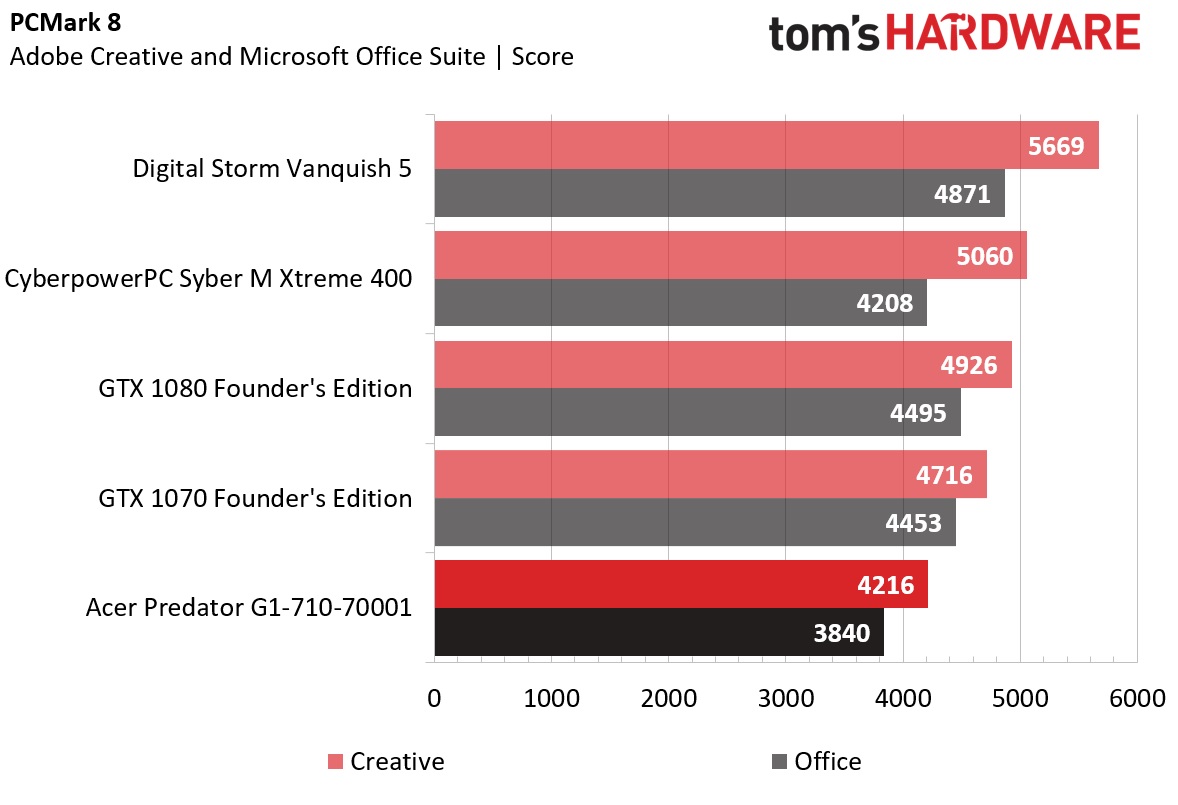Acer Predator G1-710-70001 Gaming Desktop Review
Why you can trust Tom's Hardware
Synthetic And Productivity Benchmarks
Although we may be able to predict how how the Predator G1’s i7-6700 (with a 3.4GHz base, 4.0GHz boost frequency) will perform compared to an i7-6700K-equipped PC in CPU-intensive applications, we’re still going to see what the Predator G1 can do against the likes of Digital Storm’s less-expensive Vanquish 5 (with a $2,045 MSRP) and its overclocked i7-6700K processor, which reaches an all-core clock rate of 4.4GHz. We also borrowed data from our review of CyberpowerPC’s Syber M Xtreme 400, which has two more CPU cores than both the Vanquish and Predator G1 with its Intel Core i7-6800K processor tuned to 3.8GHz (with up to dual-core operation, 3.5GHz with three or more cores engaged).
Some may feel that placing an i7-6700-equipped PC and a system with an X99 platform and six-core processor on the same scale may be unfairly tipping the scales a bit. However, if you forgive the $63 in premium fans, the CyberpowerPC Syber M is priced almost identically to the Predator G1, and we think that makes it a worthy comparison value wise.
Both the Vanquish 5 and Syber M offer half the memory (16GB) of the Predator G1. However, the G1’s memory is set to the default DDR4 frequency of 2,133MHz, and the custom shop PCs have higher memory speeds (the Vanquish 5 features DDR4-2666; the Syber M has DDR4-3000).
We also used our custom-built Z170 platform to compare the performance of default CPU, memory, and GPU clock rates of an i7-6700K, 16GB of DDR4-2133, and Founder’s Edition GTX 1080 and 1070 graphics cards. Additionally, the GPUs inside the Predator, Vanquish 5 and our test rig feature the same Founder’s Edition clock rates (1,607MHz base, 1,733Mhz boost), and the Syber M features a factory-overclocked EVGA GTX 1080 SC graphics card. We also included the GTX 1070 test rig results to see how a less-powerful GPU with a more-powerful CPU lined up against the Predator G1. The full specifications of our test bench are listed below:
Test System Configuration
3DMark
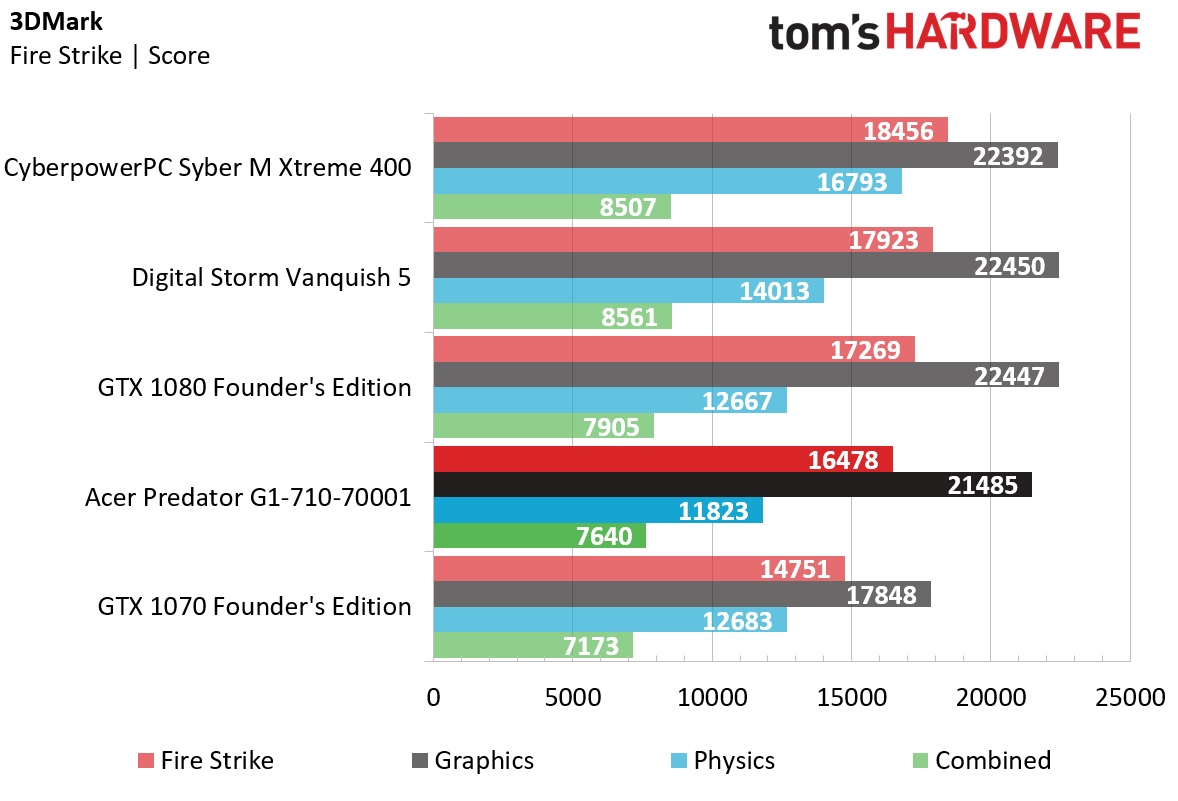
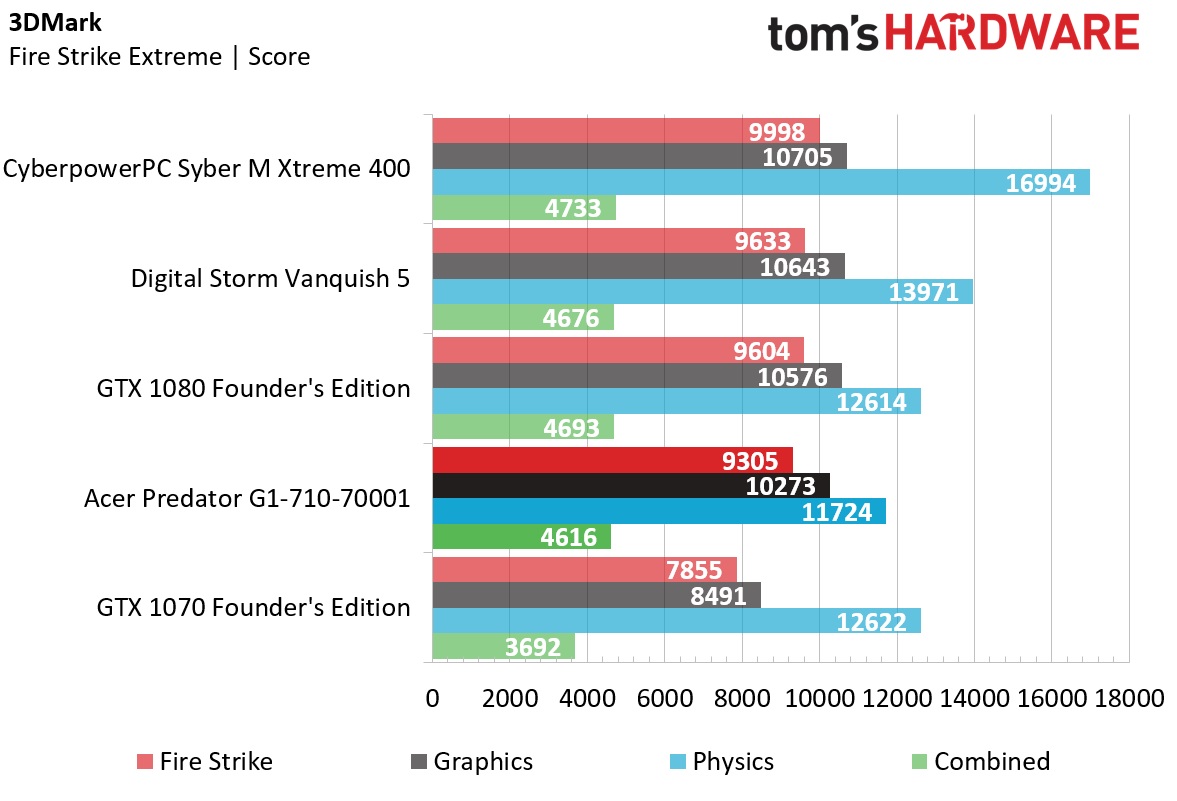
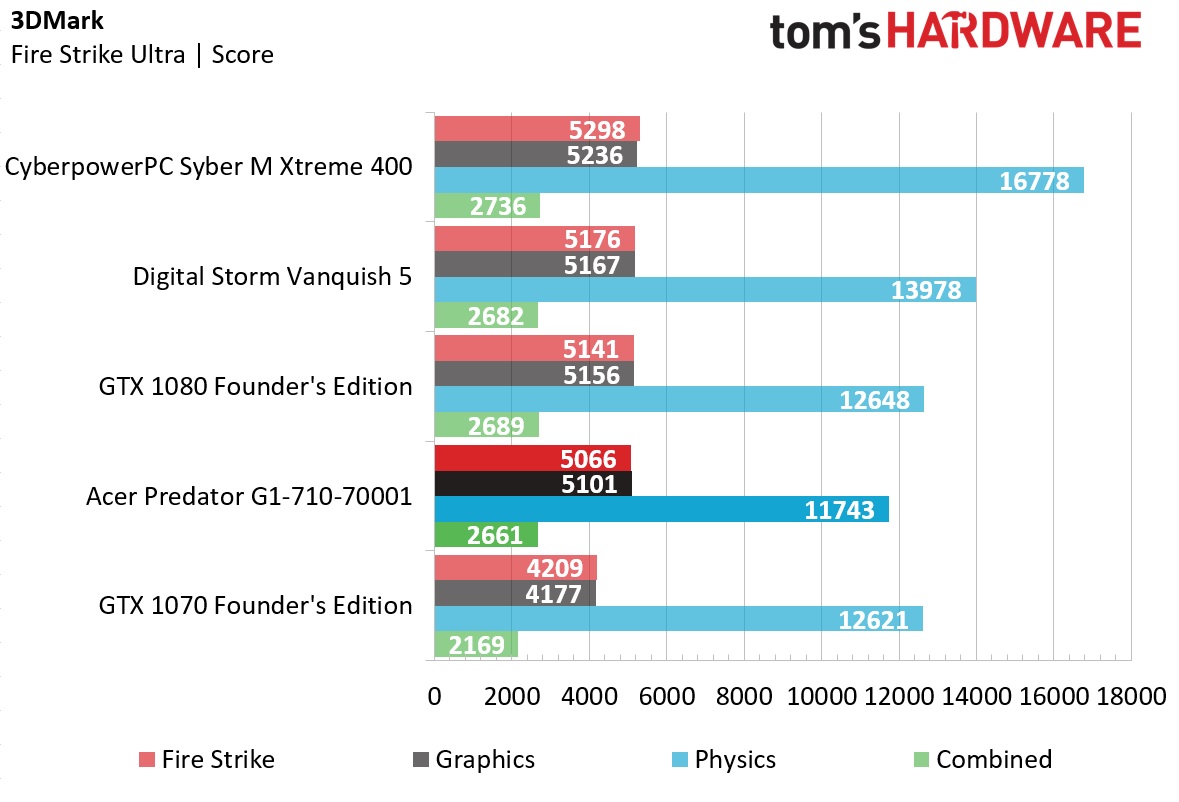
The Acer Predator G1 takes its predictable place in the group in our 3DMark benchmark results, besting the GTX 1070-equipped test rig and falling behind the systems featuring K-series (unlocked) processors with higher clock rates. The Physics test is where the G1 takes the biggest hit, with its lower-clocked CPU placing it dead last against the competition.
Although the Predator G1 only falls behind the i7-6700K and GTX 1080 systems by a small margin, the Graphics test shines a light on the Predator’s overall platform performance, which seems to hamper the G1’s GPU throughput with slightly lower results compared to PCs with the same Founder’s Edition (or reference clocked) graphics cards. The Vanquish 5 and our custom rig are only few points apart throughout the 3DMark benchmarks, but the G1 falls behind by a noticeably larger amount in GPU-focused tests.
Cinebench R15
The Predator G1 scores a win against CyberpowerPC’s Syber M Xtreme 400 in the single-threaded rendering test in the Cinebench R15 benchmark, which is no surprise considering the 200Mhz difference in peak single-core CPU clock rate (the Syber M’s i7-6800K reaches 3.8Ghz; the Predator’s i7-6700 hits a 4.0GHz turbo frequency). However, the multi-core rendering and Open GL shading tests reward the higher clocked CPUs of the Vanquish 5 and test system, and the higher core count of the SyberM, putting the Acer offering in last place among the tested competition.
Get Tom's Hardware's best news and in-depth reviews, straight to your inbox.
CompuBench
The CompuBench Video Processing results speak to the Predator’s shortcomings against more superior configurations, with even our test bench besting the G1 when equipped with GTX 1070. This is because this portion of the benchmark relies on CPU horsepower, and the Predator G1 regains its lead over the Founder’s Edition GTX 1070 in the Bitcoin Mining test. The platform performance drawbacks of Acer’s SFF gaming rig are evident against our Z170 reference system (with a GTX 1080), with the G1 falling behind systems with matching graphics cards when the workload shifts to the GPU.
Storage Test
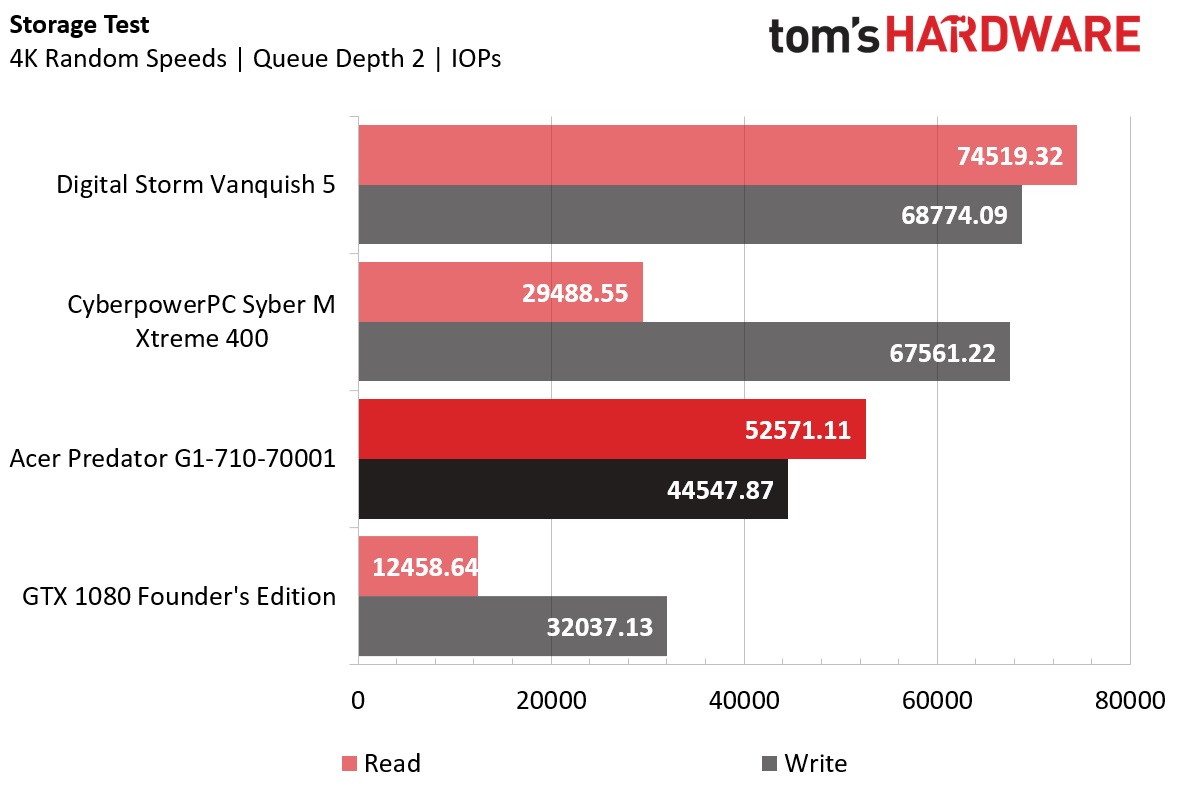

The 512GB LiteOn CV1-8B512 M.2 SSD inside the Predator G1 is on par with other SATA SSDs, and it even scores better random 4K read speeds than the Syber M’s 512GB Intel 600p NVMe SSD. This isn’t so much a testament to the acumen of the G1’s storage (it still falls behind the Vanquish 5’s Samsung 850 EVO SSD), but rather, the shortcomings of Intel’s budget-oriented TLC NVMe SSD.
Looking at sequential speeds gives the Syber M the edge (although, only by a small margin) over SATA SSD-equipped PCs, and the Predator’s SSD outpaces our reference rig’s Micron SATA SSD and comes close to the Vanquish 5’s storage performance. We excluded results for the GTX 1070, because the GTX 1080 results are from the same system.
PCMark 8
Once again, when a workload relies on overall platform performance, the Acer Predator G1 falls behind its similarly-priced competition. The 32GB of memory does the G1 no favors in the Office and Creative scores of the PCMark 8 benchmark, and even the GTX 1070-equipped reference system bests the Predator in these productivity tests.
Current page: Synthetic And Productivity Benchmarks
Prev Page Introduction And Product Tour Next Page Gaming BenchmarksDerek Forrest was a contributing freelance writer for Tom's Hardware. He covered hardware news and reviews, focusing on gaming desktops and laptops.
-
Big_D_Design It's always the same result with the Teir One companies. What a waste of time trying to get their engineers to make a gaming pc different than the boutique builds or do-it-yourself ones. You would think with all their money that they could come up with something cutting edge. The last thing I have witnessed was HP Blackbird. Now that was a well thought out Gaming PC.Reply
I find Acer to be a great company that has earned respect on many sides of the tech industry. They have shown an increase in quality in their products. I have 3 of their laptops having switched from Dell (due to Dell's quality issues with their budget offerings). I also just bought their Surface 4 clone (Switch Alpha 12) and am loving the quality of that. Fact is, Acer offers one of the best quality items as of lately. How these engineering departments get away with this substandard type of design is beyond me. Being a designer myself and a futurist, I see many missing things that can be done with Gaming PC design. But I applaud the amount of new case designs that come out daily that really are refreshing to look at. I like it clean and simple, and I like it 'Over the Top'. Fact is that we are in a place now where PC Gaming is flourishing and boy am I happy about that..... I don't know about you, but these new clear window systems are really getting quite good looking. See ya. -
sillynilly That external DOUBLE cord power supply is the stupidest thing I have ever seen on a desktop. Makes this a completely idiotic product. DUMB DUMB DUMB.Reply -
The PSU is a piece of junk. Two power cables for 460W? Maybe they has surplus of laptop power supplies, and this was a way to get rid of them.Reply
-
g-unit1111 That disc drive ruins it, IMO. I want to like that case design, but the positioning of that CD drive sticks out like a sore thumb, and that's something that could easily be done away with in this day and age.Reply -
James Mason Huh I wonder, If you guys hooked up a normal PSU to the system instead of the twin laptop PSUs, might it perform better? Or maybe just show a "regular desktop" version of it, since you probably have the same parts lying around.Reply -
g-unit1111 Reply19147638 said:That external DOUBLE cord power supply is the stupidest thing I have ever seen on a desktop. Makes this a completely idiotic product. DUMB DUMB DUMB.
I completely agree! That plus the CD drive make this one of the dumbest case designs I've ever seen. -
shrapnel_indie I can live with the optical drive. I can live with the compactness.Reply
I can't live with the price. AND... They could have at least repackaged the laptop PSU "bricks" into a single housing with the looks they tried to give it, powering BOTH units from a single cord. Two output power cables would be just the other side of acceptable, while making it a single power connection to the PC is obviously ideal.
This begs the question... Was this a Prototype Unit, a Production unit, or a hybrid of the two? Meanwhile, just give me the asking price for this unit, and, while maybe not as small, I'll come up with something easier to work in and on AND perform better.


